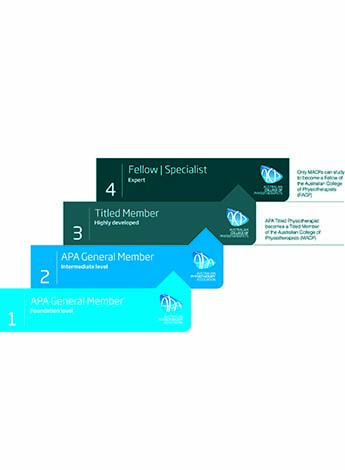
Framing career success

The APA and the Australian College of Physiotherapists continue to develop and refine frameworks for physiotherapy career progression, explains College Vice-President Barby Singer FACP.
The need to inspire and support physiotherapists to remain in the profession has never been more critical.
While many factors are at play, one key determinant of longevity within the profession is how a physiotherapist is supported along their career pathway.
The APA has articulated this support and initiative through the development of the APA Career Pathway (Figure 1) and Physiotherapy Competence Framework (Figure 2).

Figure 1. The APA Career Pathway.
The APA Career Pathway
The principles on which the APA Career Pathway is based are:
- industry-recognised standards
- transparent and rigorous quality processes
- competency-based learning outcomes
- flexible and inclusive learning processes.
The APA Career Pathway has been designed to enable individuals’ career goals and to support a national workforce.
It aims to accommodate the evolving and diverse professional development needs of physiotherapists while fostering a commitment to lifelong learning.
The framework is intended to respond to changes in physiotherapy practice and to facilitate advocacy for physiotherapists within the profession and externally.
The Pathway also aims to promote the development and retention of physiotherapists in the profession.
While the Career Pathway provides a platform for encouraging physiotherapists to work towards achieving titling (Milestone 3—Highly Developed) and Specialisation (Milestone 4—Expert), it does not assume that all physiotherapists will follow a linear career trajectory.
The Career Pathway recognises that some practitioners will develop breadth across a range of areas of physiotherapy, particularly in the earlier Career Pathway milestones (Milestone 1—Foundation and Milestone 2—Intermediate).
The APA Physiotherapy Competence Framework
About a decade ago, the APA began exploring a framework that would enable recognition of progressive competence development along a learning continuum.
Following extensive consultation, a decision was made to adapt the CanMEDS Framework for the physiotherapy profession.
The Physiotherapy Competence Framework was finalised in 2017 and introduced to APA members at the national APA conference later that year.
The Physiotherapy Competence Framework is designed to succinctly articulate the competence-based roles of the profession through quality-assured coursework, mentoring and research and to include clearly defined assessment points.

Figure 2. The Physiotherapy Competence Framework, based on the CanMEDS Framework (Frank, J.R., Snell, L., Sherbino, J., eds. CanMEDS 2015 Physician Competency Framework. Ottawa: Royal College of Physicians and Surgeons of Canada, 2015).
It aims to be transparent, flexible and agile to accommodate member needs, while clearly describing the expected level of achievement at each of the four Career Pathway milestones.
The Physiotherapy Competence Framework recognises seven role domains (Figure 2)—Physiotherapy Practitioner, Communicator, Collaborator, Leader, Health Advocate, Scholar and Professional.
Key and Enabling Competencies are housed within each of the seven role domains.
Under each Enabling Competence sit descriptors, which provide examples of the way that competence might be demonstrated.
The descriptors are not intended to be prescriptive, which provides flexibility for physiotherapists in a range of work environments.
The seven roles of the Competence Framework are usually intimately integrated in practice as represented in Figure 2.
However, for clarity and assessment purposes, there is minimal overlap in the competencies between role domains and the abilities described have been isolated, as far as possible, to a particular role.
The only anomaly is communication, which is split across two roles.
Communication with clients sits within the Communicator role, whereas communication with colleagues and other stakeholders is part of the Collaborator role.
The Competence Framework principally reflects the roles undertaken by physiotherapists interacting with patients/clients.
Physiotherapists may also work entirely in non-client contact roles, such as management and administration,
policy and planning, teaching and research.
Modifications have been made to the Competence Framework to accommodate physiotherapists wishing to be credentialed at Career Pathway Milestones 3 (Highly Developed) and 4 (Expert) in leadership or research and these new career pathways will be trialled in the near future.
Integration and implementation
In the past two years there has been an increased focus on implementation of the APA Career Pathway and Physiotherapy Competence Framework across the broader membership.
In 2022, a working party of Australian College of Physiotherapists Members and Fellows reviewed the Enabling Competencies descriptors for Milestones 3 and 4.
To provide further clarity on the distinctions between these two milestones, some of the descriptors were removed or reworded.
The latest version of the Physiotherapy Competence Framework (version 7) will be launched in early 2023.
More recently, a pilot process began for the credentialing of Titled physiotherapists (as awarded by the Australian College of Physiotherapists).
The pilot involves an evidence portfolio-based assessment process, with nine applicants submitting an electronic ‘show’ portfolio, which is assessed against the Competence Framework at Milestone 3.
In addition, two ‘reflection’ submissions were required, one providing evidence of cultural capability and the other based on a set of generic professional attributes.
Assessment is being undertaken by two experienced assessors along with a small group of ‘shadow’ assessors so as to build capacity for when the new titling credential is rolled out.
This is the first time that the Physiotherapy Competence Framework has been used to determine whether an applicant does or doesn’t meet Milestone 3 competencies in all seven role domains.
If successful in this first assessment phase, applicants will still be required to pass a clinical examination before being awarded titling in their discipline area.
Feedback from stakeholders will determine if any modifications need to be made before the process is rolled out to APA members who wish to be credentialed at Milestone 3.
The pathways to Fellowship (Specialisation and Original Contribution) of the Australian College of Physiotherapists are also under review, but will remain unchanged until at least 2024.
I wish to acknowledge and thank Wendy Nickson, Megan Dalton and Megan Davidson for their significant contribution to the original development of the Physiotherapy Competence Framework.
>> Barby Singer FACP is an APA Neurological Physiotherapist and a Fellow of the Australian College of Physiotherapists by Original Contribution (Research). She has been involved in many APA and College committees over the past four decades and is currently one of two College Vice-Presidents and the overall coordinator for the College’s Specialisation examination program.
© Copyright 2024 by Australian Physiotherapy Association. All rights reserved.





